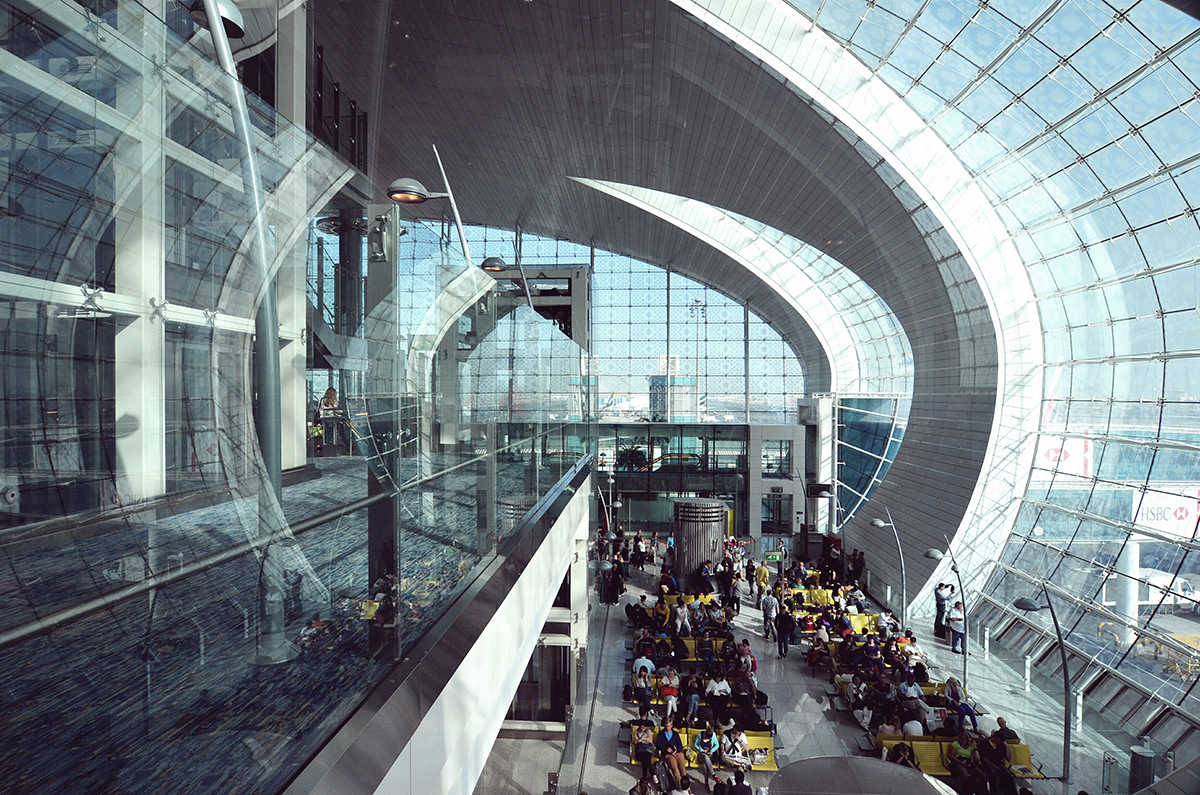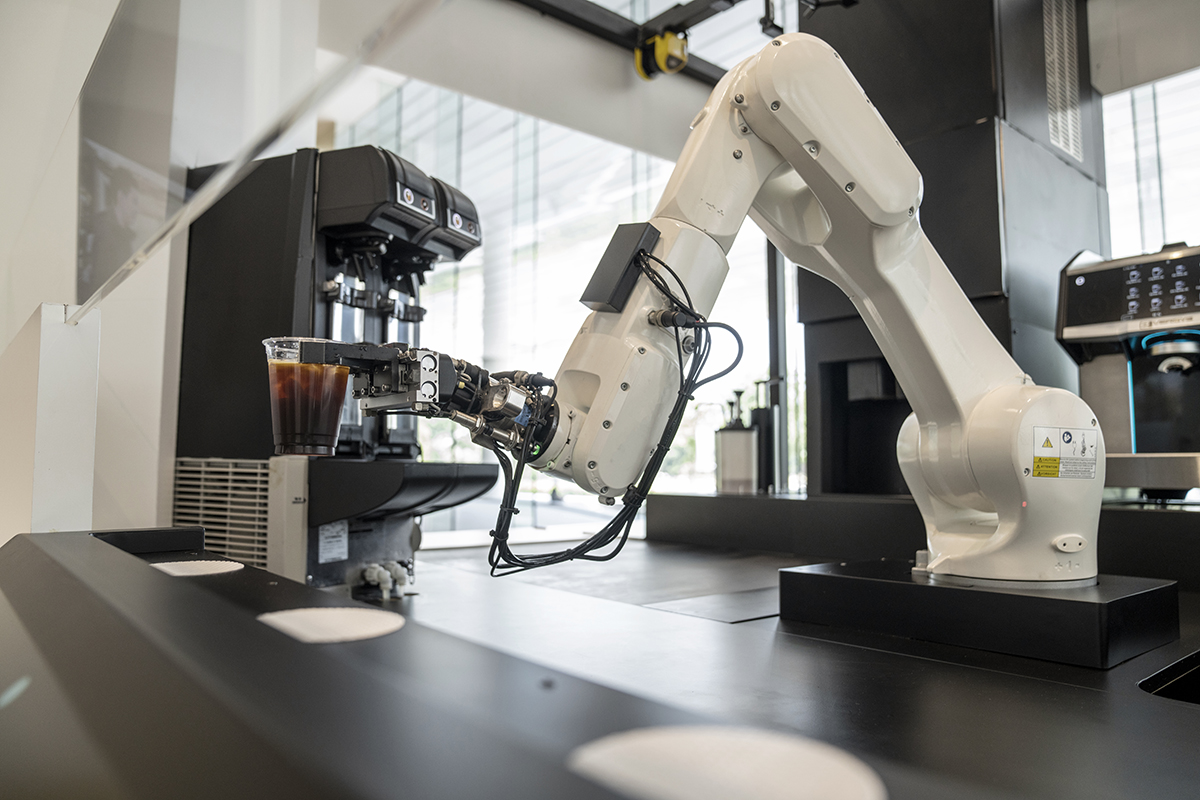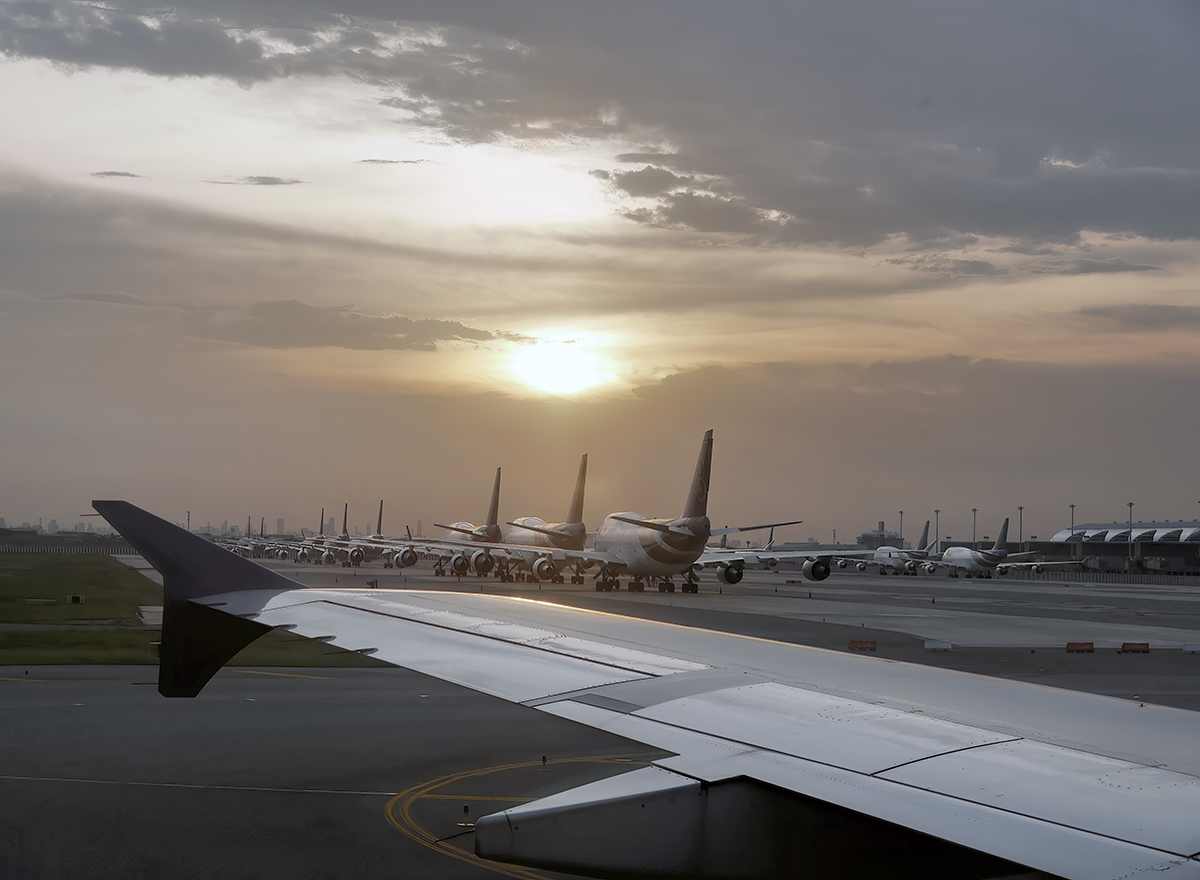Executive Summary
The state of travel – and the way people move around the world – will change dramatically in the coming decades as global priorities shift and new technologies become available. Airports will be core drivers of industrywide change, while themselves being transformed in the process.
Airports are, after all, where air travel journeys begin and end.
So, what will an airport’s purpose be in 2030, 2040, and 2050? What should leaders in the industry do to build foundations that maintain and foster global connectivity while enhancing competitiveness? What technologies need to be prioritized? And what steps must be taken to ensure innovation and change flourish in a way that helps rather than hinders surrounding communities?
Airports already play an important role in the community – at both local and global levels – and their influence will only increase as the aviation industry grows. The global commercial aviation fleet is expected to expand by 33%, to more than 36,000 aircraft by 2033, according to an Oliver Wyman analysis. Meanwhile, Airports Council International (ACI) World predicts an average annual growth of 5.8% in passenger traffic between 2022 and 2040. By 2040, more than 19 billion passengers will pass through world airports each year. This report explores:
- The trends that will shape the airports of 2030, 2040, and 2050
- What airports will look like in 2030, 2040, and 2050
- What airport leaders, industry and governments can do to pave a successful and sustainable way forward
To answer these critical questions, Oliver Wyman, ACI World, and the Sustainable Tourism Global Center identified four airport types that generally categorize an airport’s purpose and outlook:
- The City Airport: central urban location, typically servicing business travelers and short-haul commuters
- The Global Hub Connector: fans transit passengers out to the world while also serving a wide local catchment area
- The Cargo Champion: a major enabler of logistics and the movement of goods
- The Leisure Gateway: an airport that serves a tourist destination
Interviews were conducted with 18 chief executives spanning all four airport types to identify their unique needs and visions for the future.
Whilst each airport type has a different starting point, purpose, and development journey, it became clear when talking to the leaders that there are universal trends. Using these common threads, five megatrends that will shape the industry’s future were identified:
- Achieving Net Zero
- Technological Innovation
- Intermodal Connectivity
- The Changing Workforce
- The Passenger Experience Revolution
This report specifies challenges and opportunities across the five megatrends and identifies what airport leaders, regulators, and other decision-makers should prioritize to allow for sustainable industry growth from decade to decade.
Five Megatrends Affecting the Future of Airports
Achieving Net Zero
A key factor affecting the evolution of airports is achieving net zero. In 2021, representatives of global aviation industry associations committed to achieving net‑zero carbon emissions by 2050. To meet this goal, the industry will need to improve energy efficiency and transition to zero‑carbon energy and fuel sources. They will need the help of regulatory authorities in this process.
Decarbonization, the reduction of carbon emissions, is also a key investor and customer issue. Institutional lenders prefer to fund organizations that have strong environmental, social, and governance (ESG) programs in place, and Gen Z and millennial passengers are showing increasing concern for ESG models. ESG efforts resonate with passengers, with 66% saying they were more likely to purchase from an airline that had enhanced its sustainability efforts.
In 2008, aviation became the first industry to adopt a global, sector-wide climate action goal. And in October 2021, the global aviation industry declared it would achieve net-zero carbon emissions by 2050 (supporting the Paris Agreement goal to limit global warming to 1.5 degrees Celsius, compared with pre-industrial levels). Across the board, the air transport sector contributes around 2% of total global carbon emissions. The airport sector specifically is responsible for only a small slice of this, accounting for just 2%-5% of total aviation emissions.
Even though the airport sector contributes a relatively low share of global emissions, it is prioritizing achieving net zero because it recognizes its role as a key enabler in reducing the carbon footprint of the entire aviation system. Facilitating the availability of alternative fuel sources to air operators will become crucial. Increasingly, airports will become energy hubs and energy producers to supplement the resources available on the national grid level and ensure the availability of green energy. Airports will have to take concerted measures to reduce energy consumption across their ecosystem and utilize negative emissions technologies by either relying on natural processes or employing dedicated technologies such as carbon capture and storage (CCS).
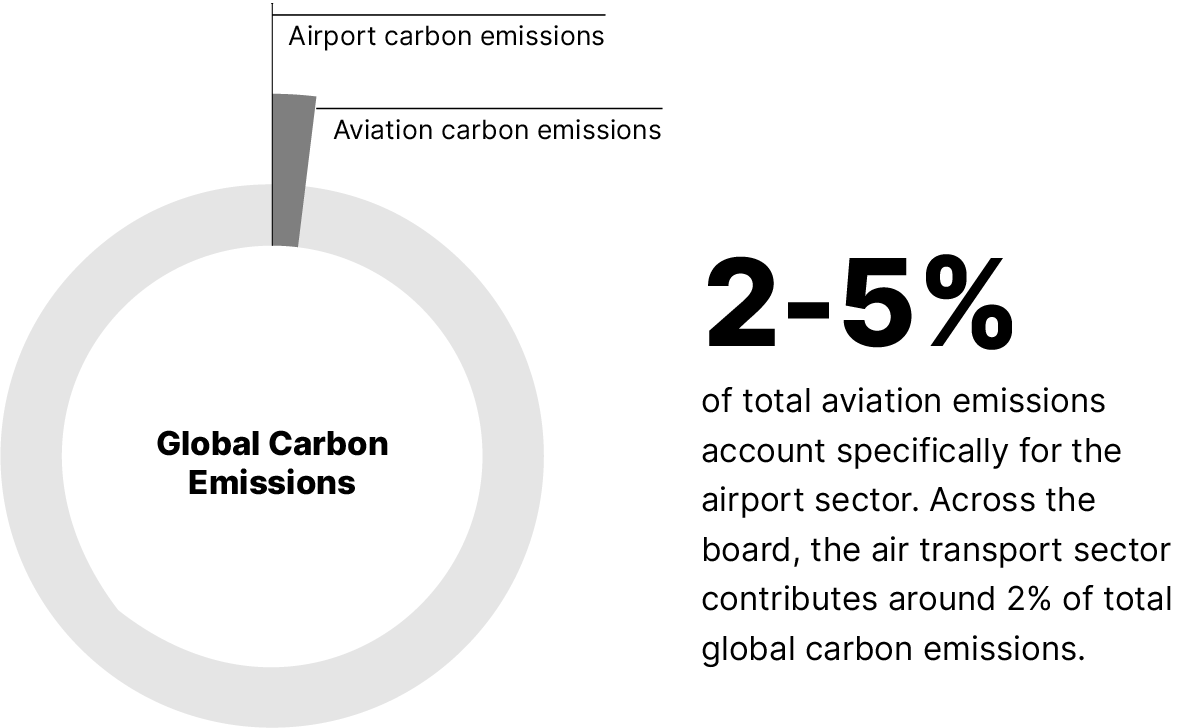
Technological Innovation
Advances in biometrics, artificial intelligence (AI) and machine learning (ML), 3D printing, and automation will disrupt traditional airport operating models and transform the customer experience while also enhancing efficiency. Progressively more travelers are embracing digitization, with 45% of air travel passengers saying they are ready to drop paper passports for digital identities.
While AI and other technologies will be used to automate predictable processes, our human resources will be mobilized to manage and humanize exceptions. This shift will require airports of the future to fully embrace digitization and innovation across cargo and passenger operations.
The deployment of technology will provide the opportunity to rethink the internal design and layout of airports, as allowances are made for “On-the-Move” passenger processing, with no or little stopping points.
The enormous potential of technology will not be realized without alignment and collaboration between regulators and the industry on data sharing. Maximizing the value of new technologies requires airports, regulators, and other members of the travel ecosystem to design and operate according to open architecture that allows seamless data sharing across multiple stakeholders, while maintaining safety and security.
Intermodal Connectivity
Airport hubs will remain vital parts of the communities they serve as providers of connectivity to their region and drivers of economic growth. As such, intermodal connectivity at both city and regional levels will be key to facilitating the movement of people and goods.
Wider societal mobility trends, including electrification and automation of vehicles, will impact airports and require coordination and collaboration with public transit agencies to develop integrated, green-transit strategies.
Disaggregated models will also emerge, with specialized terminals aiming to reduce congestion and inefficiencies. In the future, passengers could for instance travel through a fully seamless transportation system providing dedicated access to airports from city centers.
The deployment of Urban Air Mobility (UAM) concepts, providing connectivity from city centers to airports, will be fully integrated into the modern multi-modal transportation hub. These will likely connect onwards to ultra‑high‑speed rail networks, providing additional inter-regional connectivity options.
The Changing Workforce
At present, approximately 54% of the 11.3 million people working in the aviation industry work in airports, amounting to 3.9% of the total travel and tourism industry (289 million people). Labor shortages that began in the wake of COVID-19 persist within the aviation industry, and they threaten to limit the ability to meet the growing demand for travel.
Looking ahead, as AI and other technologies transform airport operations, the workforce’s roles will bifurcate, and required skills will be more specialized: passenger-facing workers will have to upgrade their customer service skills, whilst airport operations staff will need new engineering, digital, cybersecurity, and IT skills.
In addition to shifts in the skills required to ensure the competitiveness of airports, the industry will also need to prioritize attracting and incentivizing the diverse and multi‑tasking workforce that is Gen Z. In this context, collaboration with academia will be necessary to create interest in the aviation industry, facilitate the recruitment of sufficient numbers of aviation workers to cater to future demands, and ensure workers have the right future‑proofed skills.

The Passenger Experience Revolution
Going forward, the passenger experience will be customized, on-demand, contactless, and efficient. The digitization of airports will enable a tailored end-to-end journey through the airport and will create new retail and commercial revenue opportunities.
Airports and airlines will offer personalized baggage drop-off and pick-up options, with the intent that passengers will no longer need to travel to the airport with their baggage. For example, luggage will be sent to the airport from home or hotel before departure through luggage pickup and checking services. Passengers will use personal devices and integrated travel apps to manage every aspect of their journey and consumer experience, from reserving a table at a restaurant to accessing duty-free purchases. Airports will offer services to customers at every point of their journey, as well as targeted promotions. However, these improvements in customer experience can only be achieved through data availability and open exchange.
Beyond digital innovation, physical spaces will need to be designed and transformed within airports to accommodate passenger demands. For instance, airport lounges are growing in popularity, and airlines are requesting that facilities be upgraded in terms of size and customer experience by providing new experiences such as cinemas, pools, or virtual‑reality gaming options. The continued expansion of airports into “aerotropolises,” or airport cities, will provide customers with a host of interrelated activities on‑site or nearby.
The transformation of passenger processing will drive a significant change in the internal layout of airport terminals where the future line of demarcation between airside and landside is expected to be very different from today. The reduction in check-in counters and security screening queues will provide new opportunities for commercial retail and relaxation spaces in terminals.
Four Airport Types
City Airport
The City Airport serves major urban centers, providing connectivity and acting as a gateway for business, leisure, and family travel. These airports are best viewed as part of the public transport system: one of their functions is to be an intermodal point to other vehicle types. This type needs to be cutting edge when it comes to ease of use as an airport.
Given their central location, the leaders of this type have a strong awareness of and sensitivity to the impact of factors such as noise and other types of pollution, and they work closely with local communities to mitigate these risks. These airports are often capacity-constrained, particularly in terms of options for infrastructure development. While City Airports in Europe are relatively mature, the executives interviewed believe that City Airports in Asia and the Middle East will be growth engines for regional travel in the coming decades.
"If we were to build more parking lots, they would be empty. We have the national railway system, which has its station within the airport, and we are a hub for buses, so are already well integrated and working to improve further. That’s our main target. Hence, the need to integrate airports more within overall public transport systems"
– André Schneider
CEO, Geneva Airport
Global Hub Connector
The Global Hub Connector type has a dual focus on transit passengers as well as travelers within a wide local catchment area of the airport. This gives rise to a strong need for intermodal connectivity to population centers, high-quality customer experience, and smooth and efficient processing. In the coming decades, this type will continue to play an important role in connecting passengers across the globe. Technology and smart design will allow global hub connectors to mitigate congestion and introduce seamless journeys.
"Imagine a long train where you’ve got individual pods joined together. Each one is designated to go to a specified terminal. That train takes you directly to your micro terminal where your New York flight is waiting. You could even have pods that decouple as you go along. You have the intimacy of a small airport, with the complexity and economies of scale of a large one, but the passenger doesn’t need to see the huge scale of background processes. Their journey is highly personal and instant."
– Paul Griffiths
CEO, Dubai Airport
Cargo Champion
The typical Cargo Champion airport will need to explore technological innovation, greater data sharing, and improved surface connectivity to meet demand, as e-commerce grows alongside customer and business expectations for fast delivery.
Memphis, Narita, and Shanghai Pudong are examples of cargo champions. As Chairman of the Board of Directors at Shanghai Airport Authority, Yun Qin highlighted that “[they] will collaborate closely with public ground transport entities and improve the interconnectivity of the information systems to develop intermodal services” with the aim of “improving the quality of service to the city as well as the region.”
Narita Airport’s President and CEO, Akihiko Tamura, explores the potential to revise conventional approaches in the face of adversity – “The emergence of labor shortages is an opportunity to rethink conventional approaches to airport activities. In areas where labor shortage is critical, such as ground handling and other airside operations, the use of digital solutions will improve human resource and work efficiency.”
"We want the airport to be successful. We want our largest airline partner to continue to grow and remain a large portion of MEM’s approximate $20 billion a year economic impact."
– Steve Brockman
CEO, Memphis International Airport
Leisure Gateway
For the Leisure Gateway airport, passenger experience is key, and the goal is to start the holiday experience at the airport. Today, leisure airports such as Punta Cana in the Dominican Republic and Carrasco International Airport in Uruguay are a gateway to the destination they serve, but in the future, they will become a part of the destination itself. Airports will leverage the local culture and a sense of community warmth to provide unique cultural experiences to guests. However, these airports struggle with the fluctuating passenger demand associated with peak and off-peak holiday seasons.
"Time is more important than ever … If I want to spend time in airports, it must be my choice, not because of the queues, the controls. We have to use biometrics, and we have to use AI to predict and to reduce the time we lose in terminals."
– Diego Arrosa
CEO, Aeropuertos Uruguay
Megatrend Evolution
Flight Path to 2030
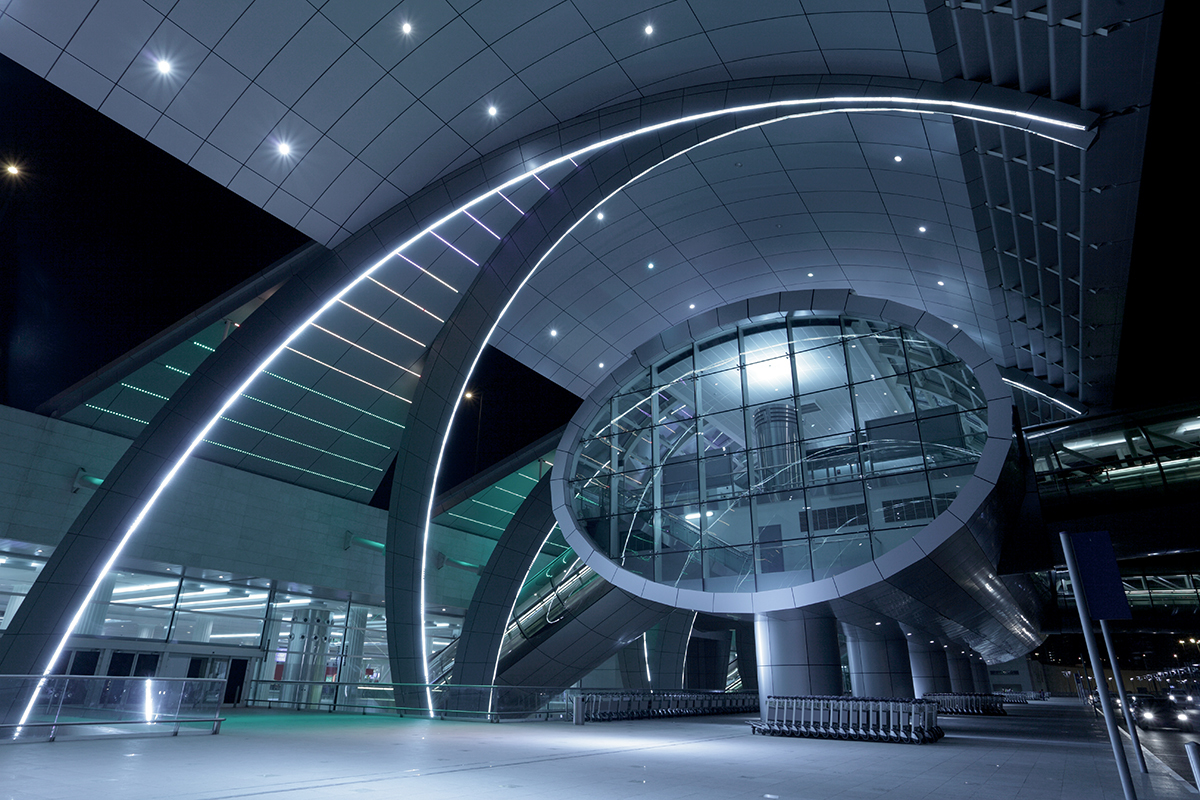
Achieving Net Zero
Global decarbonization efforts and regulations will impact passenger demand. For instance, in December 2022, France passed the first legislation to prohibit flights between cities that can be reached by train in 2.5 hours or less. It is expected that other European countries will follow suit and by 2030 multiple cities could prioritize rail transport over short-haul commercial flights. In the near term, introducing carbon credits or offsetting schemes should be considered while airports develop new solutions.
A key priority by 2030 will be increasing the supply and commercialization of sustainable aviation fuels (SAF), which can be produced from waste products or sustainable feedstocks that limit the risk of unintended environmental and social consequences. However, the availability of sufficient volumes of SAFs will be an issue. Under a best-case scenario calculated by Oliver Wyman, there is likely to be 5.4 billion gallons of SAF supply by 2030, whereas the industry will require 16 billion gallons by then just to keep emissions at 2019 levels.
By 2030, the electrification of airport vehicles and ground support fleets will be firmly in place. Airports are already experimenting with electric autonomous vehicles to move staff and cargo between locations on the airfield, allowing transport needs to be met by a smaller fleet of vehicles. In addition, airports can further reduce fuel consumption on the ground by using electric airplane tugs.
Reducing overall energy consumption will include a focus on airport facilities, such as lighting and cooling which account for 46% of the overall airport energy use. The use of sustainable construction materials when airports renovate or expand will be hugely important. Many airports have embraced decarbonization through investments in solar panels, and others are moving towards carbon neutrality. For example, Dallas Fort Worth International recently became the first carbon-neutral airport in the Americas by weaving environmentally sustainable practices throughout its operations – from water usage to energy consumption and waste management.
While noise pollution remains a challenge for airports surrounded by population centers, this will likely be less of a factor by 2030 and beyond due to new-generation aircraft and innovative engine types, including electric and hydrogen-powered, which are likely to reduce the noise footprint over time.
Technological Innovation
Airlines, airports, and governments continue to invest in biometrics and digital identity management solutions given their potential to create a safer, seamless, and contactless end-to-end passenger experience. By 2030, wider implementation of biometrics is expected to replace paper passports, boarding passes, and other travel documents such as visas.
By 2030, these technologies will have had one and a half decades of precedent: in 2015, Aruba Airport introduced its Happy Flow system which uses facial recognition, taking a biometric photo of a passenger that is then linked with their passport so that the passenger needs to only stand in front of a camera at almost every passenger touchpoint, excluding security screening.
Previously only usable by residents and citizens, the biometrics program at Dubai International Airport was extended in 2023 to international travelers. A pre-populated biometric database means passengers can now pass through check-in, lounges, boarding, and immigration, with AI linking their unique facial features to their passport for instant verification.
The sharing of data, while ensuring data security and integrity, is central to the implementation of biometric technology. Many of the airport CEOs interviewed agreed that the different rules and regulations in different jurisdictions create a complex environment that does not facilitate the exchange of data. Nevertheless, passengers increasingly prioritize efficiency and seamlessness, with 73% of passengers today stating their willingness to share their biometric data to improve airport processes (vs. 46% in 2019).
A more seamless approach will also exist for baggage management by 2030, with customizable, contactless, and varied solutions. Options will include collection from and delivery to origin or destination using a third-party logistics service – already available at some airports at a cost – as well as bag-drop points at designated locations throughout the community.
Paper baggage tags will be progressively replaced by 2030, leveraging electronic luggage tags that can be updated with a passenger’s journey details and tracked on a smartphone. Recent changes to the International Civil Aviation Organization’s (ICAO) guidance now allows for electronic bag tags to be used for checked baggage. Replacing paper tags with reusable electronic tags will not only save passengers time spent checking in at the airport but will also have environmental benefits.
Expanded airport capacity will need to be carefully considered, especially in the Middle East and Asia where ACI World estimates that $2.4 trillion will be needed by 2040 to accommodate growth. From a maintenance perspective, 3D printing will make maintenance operations more cost- and time-efficient, providing airports with a competitive edge compared to traditional market players.
By 2030, AI and the Internet of Things (IoT) technology will be a core part of airport operations. The use of a digital twins of an airport will lead to faster and better decision-making through the visualization, stimulation, and prediction of hypothetical situations and changes.
The speed of technological change cannot be untangled from cybersecurity threats. Autonomous vehicles, biometrics, and a growing online footprint all increase the potential surface area for a cyberattack. According to the World Economic Forum’s Global Risk Report 2023, “widespread cybercrime and cyber insecurity” is a new and heightened risk – ranking as the eighth-most important global risk across both a two-year and eight-year timeframe.
The aviation industry sits within a broader geopolitical landscape that includes intergovernmental policies, security concerns, national interests, economics, and society. Reaching industry alignment is paramount, and without a common understanding and approach to emerging threats, airports may struggle, or even fail, to come up with effective cyber resilience measures.
Intermodal Connectivity
With a push towards sustainability and away from personal vehicle transport, the airports of 2030 will need to be connected to wider public transport networks – an issue which will be particularly important for City Airport types. Airport operators will need to coordinate with local transport operators to prioritize efficient operations.
The development of rail infrastructure to and from airports offers great opportunities for intermodal connectivity; and as transfer time is reduced, public transport methods will become more attractive.
Most Leisure Gateway airports have traffic that is highly seasonal. To make up for fluctuations in passenger traffic, these airports could explore bolstering cargo operations. Even during peak season, the belly hold of many passenger aircraft still has capacity to carry cargo, as tourists tend to travel light.
The Changing Workforce
During the pandemic, an estimated 121 million travel and tourism jobs were lost. In 2021, the aviation industry’s workforce contracted 43% from pre-COVID levels, and it has yet to recover. Labor shortages cut across the entire value chain, from pilots to mechanics to baggage handlers, and threaten the ability of the industry to meet growing travel demand. In particular, the pilot shortage is a long-standing trend that will continue to impact travel supply in the next decade, with an estimated 60,000 additional pilots needed globally by 2032, including 17,000 in North America and 17,500 in the Middle East.
For the first time in history, four generations are co-existing in the workplace – each with its own values, beliefs, behaviors, and level of commitment to their employer. The demands of the workforce of the future present a unique challenge to airports where onsite work is required: 85% of Gen Z prefer hybrid or remote work environments. In the transportation industry, work-life balance is a key driver for Gen Z and compensation is low in priority; this means that airports will need to develop more sophisticated, tailored ways to attract, manage, motivate, and retain this emerging workforce.
Lessons can be learned from Singapore’s Changi Airport, which was named Singapore’s Most Attractive Employer by Randstad in 2016 and 2018, excelling in areas of career progression, financial health, interesting job content, work atmosphere, and active adoption of innovative technologies.
Beyond attraction and retention, upskilling will be key. Indeed, there is an increased demand for employees with digital or technical skillsets, as well as individuals with soft skills to undertake core customer‑interfacing roles.
The Passenger Experience Revolution
As the airport is the first and last touchpoint for travelers, the airport experience plays a significant role in how visitors remember a destination; therefore, making the passenger experience seamless and enjoyable is important. Comfortable lounges, diverse food and beverage outlets, and free Wi-Fi are increasingly becoming must-haves for consumers. With increased focus on the customer experience, airports will need to leverage and monitor opportunities for obtaining feedback to ensure passengers’ demands are satisfied.
By 2030, the expectation is that the integration of new technologies will enable airports to deliver passengers customized, on-demand services to improve their airport experience. One such example is the implementation of virtual queuing instead of joining a physical line. Seattle-Tacoma International Airport (SEA) and Los Angeles International Airport (LAX) are among the first airports in North America to have trialled the system, while some airlines, such as Delta, have used a similar tool to notify passengers when their seat is boarding.
Airports are exploring new ways of doing business via e-commerce, with platforms offering on-demand experiences such as delivering food and drink in time for the flight, creating brand experiences within the terminal, and offering opportunities to purchase duty-free products online to be delivered at the destination. Such personalized packages become particularly valuable at Leisure Gateway airports, where there is an even greater focus on the experience.
Flight Path to 2040

Achieving Net Zero
The year 2040 will be a decade away from the net-zero goal. Some of the executives interviewed believe that airports will in fact need to be net-zero in at least Scope 1 and Scope 2 emissions by 2045.
The first hydrogen aircraft are expected around 2035, and there is much hope about the potential for net-zero long-haul flights thanks to this clean technology. At the same time, manufacturers will start commercial operations of short-haul electric aircraft, but battery capacity constraints mean long-haul electric is likely off the table. Electric propulsion will also be key to limiting the noise footprint of airports – a common community complaint that will be potentially compounded as air travel demand increases.
On a non-aeronautical revenue front, technological improvements in carbon capture could also turn airports into green energy power stations. Direct-air carbon capture could become a source of clean energy not only for airports but also for planes. However, the transition to becoming a “green airport” will require substantial investment – existing airport facilities will need to be retrofitted and new infrastructure to be built in line with net-zero carbon standards. The SAF uptake will be an opportunity for airports to define an operating model with energy producers.
The greatest potential for airport decarbonization lies in increasing airline operational efficiency and reducing aircraft fuel burn. The route a plane takes, the height it flies, and the weather it flies through all impact CO2 emissions. Air traffic management has the potential to have a huge impact on fuel efficiency, and improved technologies and the implementation of “free-route airspace” could raise efficiency and reduce emissions.
Technological Innovation
When it comes to transportation within and around the airport, autonomous electric vehicles and equipment can transform the entire turnaround process of fuelling, catering, cleaning, and pushback, thus resulting in significant operational improvements and emissions savings. Airports will get the opportunity to repurpose car parking space by reallocating existing capacity or scaling down the available space. Meanwhile, autonomous delivery robots are becoming an increasingly common sight at airports, especially in the US, and are likely to be more widespread in 2040. Cincinnati/Northern Kentucky International Airport launched a fleet of fully autonomous delivery robots for food and retail in 2022.
Unmanned aerial drones will be widely used by 2040 – providing runway inspections and perimeter security over large areas more quickly (and more safely) than humans, while capturing high resolution images and videos. Drones have other applications, including topographical surveys and wildlife hazard management. Given the high level of airport security, there are concerns on how to deal with drones and other unmanned vehicles that could potentially pose a threat. Another potential issue with the use of drones is noise pollution, as some communities find the noise from drones more disturbing than that of aircraft, due to proximity. Finally, drone battery life must be extended significantly in order to reduce the operating cost of a drone.
Carbon capture, utilization, and sequestration (CCUS) technologies will have evolved significantly by 2040 and they offer a complementary solution to alternative fuels. Early experiments with Direct Air Capture (DAC) technology – which removes human-induced CO2 directly from the air – have yielded promising results.
For passengers, touchless travel digital ID cards may replace paper passports by 2040, acting as a single source of truth that confirms the passenger’s identity, health details, passport details, past and current travel information, and visa details. This digital ID combined with biometric technology means passenger processing, including security clearance, could be a completely uninterrupted and touchless journey conducted at a walking pace. In fact, many security processes will likely be integrated with modes of transport – so that a passenger’s details can be verified while they are traveling from city to gate, for instance.
Overall, the travel hub of 2040 will be all about open-airport architecture, with physical and software design interfacing and allowing for touchless security and check-in. Leaders believe that this will facilitate the sharing of data and will improve security and cooperation between airport operators and regulators.
As Justin Erbacci, CEO of Los Angeles International Airport, noted, a lot of this technology is “already here. It’s just about combining it and getting more standardization across the globe so that we don’t need to have multiple types of technologies depending on the airport or the airline.”
Intermodal Connectivity
The airport of 2040 will need to be connected in myriad ways. Urban air mobility (UAM) and electric vertical take-off and landing aircraft (eVTOL) will offer a potential integrated, affordable, shared transportation system that operates seamlessly across surface and air transportation to connect airports and their surrounding cities. Airports will need to invest in infrastructure to integrate this new mode of transport into their operating and business models, and this infrastructure may require the repurposing of airport parking lots. However, private transit to the airport will still be necessary, and so the infrastructure will need to accommodate trends for electric and automated vehicles – including installing charging stations that can be used for both airport parking and ride-hailing services.
Stefan Schulte, CEO of Fraport AG, noted that “public transit is [likely to become] much more individualized, in that you will be able to order a bus as an individual and there are four or five other people with you, so it will be like something in between a car and an official bus lane”.
The Changing Workforce
By 2040, technology will have profoundly changed the airport workforce. Technology will enhance and facilitate airport jobs, allowing staff to focus on customer interactions. New tech-focused roles that are core to operations will emerge, in particular around data science and the use of AI.
Technology will support and replace some traditional roles such as baggage handling, while in-app concierge services and delivery robots will support other jobs in the airport of 2040.
Despite automation, there is broad agreement that there will continue to be customer-oriented roles at airports that focus on the less predictable tasks, but that these employees will need updated skill sets. Such jobs include serving as an “ambassador” to welcome guests into a country, as well as supporting customers with mobility or directions. Meanwhile, strong upskilling in areas such as engineering, IT, maintenance, and digitization will be needed to maintain and manage systems such as electric aircraft, hydrogen technologies, and drones.
The Passenger Experience Revolution
The 2040 airport experience will be more of a service-oriented one, including fast-tracked parking, integrated journey planning, quick security, and personalized wayfinding. Numerous CEOs believe airports are more than just runways and terminals, with Gert-Jan De Graaff, CEO of Brisbane Airport Corporation, noting that they “will further develop vibrant urban campuses that contain offices, hotel, retail offerings, but also entertainment and different modes of transport to the airport.”
Investment will be made into building wider networks of interrelated businesses and activities to create airport cities, or “aerotropolises.” These are metropolitan areas that are centered – in terms of economy and infrastructure – around an airport, utilizing land not suitable for residential development. Land uses include shopping centers, entertainment complexes and event arenas, health and recreation facilities, hotels, e-commerce infrastructure, and even schools. Today, Asia leads the way in this field, with China incorporating the principles in more than a hundred airports. Singapore’s Changi Airport already has “Jewel,” a dome-shaped attraction that houses a dynamic mix of retail, leisure, garden, and hotel amenities, as well as airport operations. Meanwhile, the Middle East is catching up. Riyadh Airport is to be expanded to become an aerotropolis with airport support facilities, residential and recreational facilities, and retail outlets, to accommodate 185 million passengers by 2050.
This aerotropolis model is about transforming the airport into a destination rather than just a place to catch a plane – and it is also about decoupling airport revenues from air transport and building commercial resilience.
Flight Path to 2050
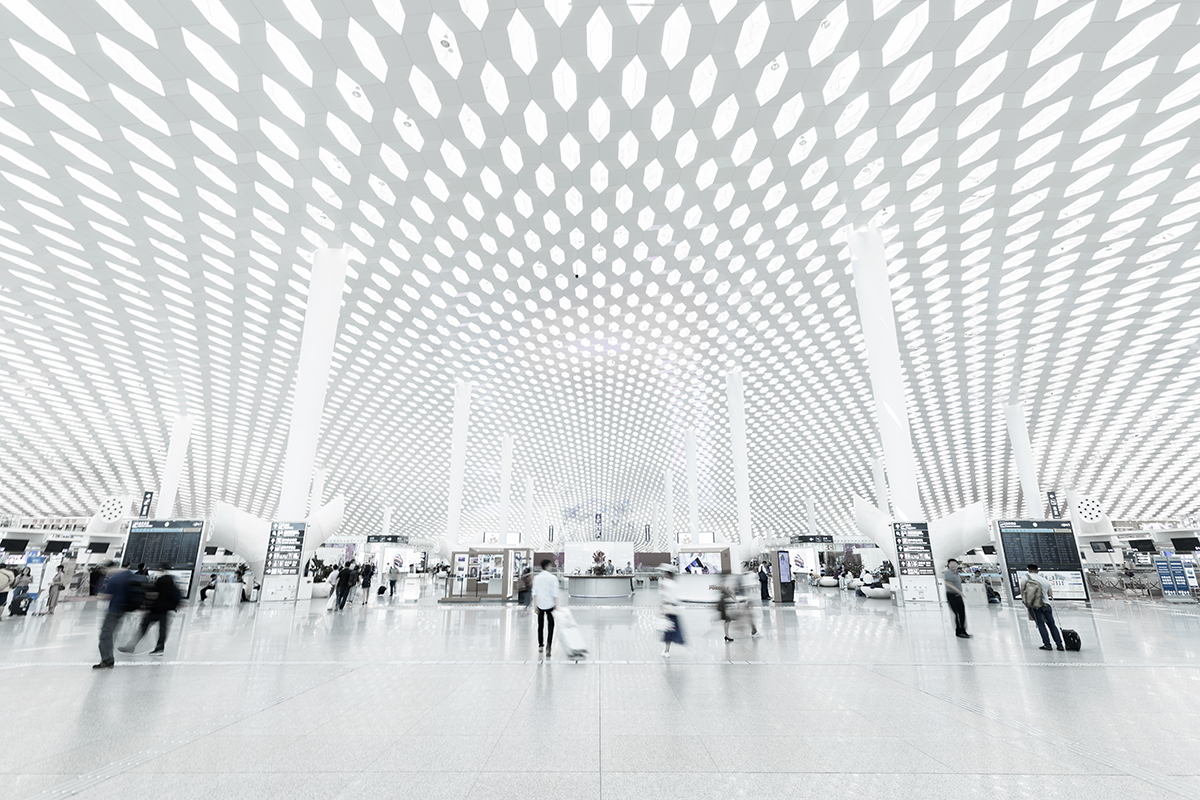
Achieving Net Zero
With the industry-wide goal of net-zero carbon emissions by 2050, environmental sustainability will need to be at the heart of the airport’s business model. In some cases, carbon-offsetting mechanisms will remain critical to this pledge.
By 2050, airports will be energy producers and hubs, providing energy sources to users and communities and helping with decarbonization and sustainable revenue streams.
Technological Innovation
By 2050, many processes within airports will be fully autonomous, increasing the speed and quality of activities – from security to immigration and boarding. These efficiencies will also bolster cargo operations.
There will likely be no more huge departure and baggage handling lobbies; such space-saving processes would be particularly important for City Airports, where land is at a premium.
The passenger processing experience could feel like a walk in the park, and this will be especially important to Global Hub Connectors where high volumes of people are processed daily. Today, Changi Airport’s Terminal 4 is an early example of a fully autonomous terminal with automated processes for check-in, baggage drop, immigration, and boarding, thanks to facial recognition technology. Many other terminals and airports are to follow – and build upon this model – by 2050. For example, Royal Schiphol Group has launched a major program to create a fully autonomous airport by 2050.
Through coordinated efforts by governments and regulatory bodies, there is a prospect of having an internationally recognized digital identity for all passengers by 2050.
Intermodal Connectivity
In 2050, airports will be models of connected and integrated travel. They will be community hubs for city and regional links, and mass transit of many kinds, including high-speed rail, autonomous vehicles, hyperloop, air taxis, and so on.
Significantly more integrated system-flow management concepts are expected, balancing demand and capacity across airport operations. Geneva Airport (a City Airport) is already using airport collaborative decision-making (A-CDM) to avoid planes sitting idle on the runway when their arrival gate is not ready. In the future, the airport envisages taking A-CDM a step further and integrating decision-making into the wider public transport system to include buses and trains.
The design of the Global Hub Connector airport of the future will need to be completely reimagined. Rather than having a road and rail system that drops passengers off at a front door of a main terminal, gates could be reached directly via sealed trains or pods. Or, as in Incheon International Airport, the introduction of autonomous electric vehicles could transport passengers around the airport for smoother connections. Some CEOs suggest a disaggregated model of smaller terminals is needed to allow for a more efficient passenger flow, as opposed to funneling passengers through a central processing area.
The Changing Workforce
By 2050, it can be assumed that robots and automation will have taken on most of the current roles at airports – replacing staff at restaurants, bars, and other areas of the departure hall. Already, San Francisco International Airport has opened retail Cafe X, a completely robotic, self-service cafe. From a cargo perspective, full automation will be used for sorting and processing, given the 24/7 nature of the business. It can also be expected that robots will use AI and facial recognition to guide passengers around the airport, or that Metaverse capabilities will be deployed to help people navigate airports. In 2050 airports, roles for humans will likely be limited to where they provide the most value – soft skills.
The Passenger Experience Revolution
Zero-queue terminals will be a reality by 2050, with customized and pre-planned processes creating a seamless journey from home to destination, and back. Passengers will use their personal devices or travel and airport apps to control every aspect of their journey and experience.
Remote processing and one-stop processing pods which may be available during the transit time to the airport, will simplify boarding and security procedures. This will be crucial for both City Airports – where time and space are a premium – and Leisure Gateway airports, where tourists increasingly taking frequent yet shorter vacations, and expect to receive better service whilst spending less time at the airport.
Conclusion
Thinking about the future now will allow for airports, and for those regulating them, to ensure that these key economic drivers are sustainable on many fronts – environmentally, commercially, and in terms of community support.
While the 2050 outlook may seem far off, interviews conducted with CEOs show that the airports of tomorrow will be shaped by the approach taken towards the challenges of today.
The industry pledge to become net zero by 2050 requires an enormous, coordinated effort across the aviation ecosystem. The vast majority of aviation emissions are due to aircraft fuel burn, and reducing this will require time, funding, and technological breakthroughs in aircraft and propulsion innovation. SAF will play a role in the medium term, but hydrogen and electric aircraft will start growing in scale by 2040.
Biometrics, big data, and other connected technologies will improve the passenger experience while also enabling airports to manage facilities more efficiently. This is an exciting win-win situation, but due to inflexible, legacy infrastructure, some airports will need time to integrate new features into their architecture.
Meanwhile, the uptake of new technologies such as eVTOL, electric, and automated vehicles will affect airport design, from parking lots to runway safety protocols. These changes have the potential to evolve the role of airports in the urban mobility landscape, turning them into intermodal hubs.
A key question is: will airports get bigger or smaller? Demand for air travel will continue to grow, and large aerotropolises will expand the boundaries of airports. In parallel, technology will allow for remote passenger and bag processing as well as smaller runways due to vertical take-off and landing. Indeed, it may mean that there will be two different sized airports that flourish – ones that are much larger than today’s average size airport, such as the Cargo Champions of tomorrow, and ones much smaller, such as the City Airports close to urban centers. Matching the growing demand for travel with workforce constraints is another medium-term challenge that will require industry investment, but by 2050 many process-driven roles will be automated. However, our human resources will continue to be utilized to manage and humanize exceptions. Advance planning, public-private collaboration, and community engagement will be important differentiators of leading-edge airports. The CEO interviews – and the supporting data – make it clear that there is a common thread to what is keeping airport leaders up at night, but also to what motivates them each day: a safe, seamless, contactless, and pleasant traveler experience that protects the planet. The passengers of the future have much to look forward to.
Acknowledgment
Airports are a critical enabler of the global economy and their importance is set to grow in line with the travel industry. To future-proof our infrastructure, airport leaders, regulators and other decision-makers must anticipate changes and prioritize initiatives for 2030 and beyond.
This report was created by Oliver Wyman, Airports Council International (ACI) World, and the Sustainable Tourism Global Center (STGC), incubated by the Ministry of Tourism of Saudi Arabia, to assist ecosystem players on their journey to 2050. It aims to map out the biggest disruptors airports can expect, along with potential solutions highlighted in case studies.
It is essential for industry leaders to build a common understanding of what lies ahead. Preparing the future of airports starts now.
Oliver Wyman
Oliver Wyman is a global leader in management consulting. With offices in more than 70 cities across 30 countries, Oliver Wyman combines deep industry knowledge with specialized expertise in strategy, operations, risk management, and organization transformation. The firm has more than 6,000 professionals around the world who work with clients to optimize their business, improve their operations and risk profile, and accelerate their organizational performance to seize the most attractive opportunities. Oliver Wyman is a business of Marsh McLennan [NYSE: MMC].
The Oliver Wyman Forum
The Oliver Wyman Forum is committed to bringing together leaders in business, public policy, social enterprises, and academia to help solve the world’s toughest problems. The Oliver Wyman Forum strives to discover and develop innovative solutions by conducting research, convening leading thinkers, analyzing options, and inspiring action on three fronts: Reframing Industry, Business in Society, and Global Economic and Political Change. Together with our growing and diverse community of experts, we think we can make a difference. For more information, visit oliverwymanforum.com.
Airports Council International (ACI)
Airports Council International (ACI), the trade association of the world’s airports, is a federated organization comprising ACI World, ACI Africa, ACI Asia-Pacific, ACI EUROPE, ACI Latin America and the Caribbean and ACI North America. In representing the best interests of airports during key phases of policy development, ACI makes a significant contribution toward ensuring a global air transport system that is safe, secure, efficient, and environmentally sustainable. As of January 2023, ACI serves 712 members, operating 1925 airports in 171 countries.
The Sustainable Tourism Global Center (STGC)
The Sustainable Tourism Global Center (STGC) is the world’s first multi-country, multi-stakeholder global coalition that will lead, accelerate, and track the tourism industry’s transition to net-zero emissions, as well as drive action to protect nature and support communities. It will enable the transition while delivering knowledge, tools, financing mechanisms and innovation stimulation into the tourism sector. The STGC, incubated by the Ministry of Tourism of Saudi Arabia, was announced by His Royal Highness the Crown Prince Mohammed Bin Salman during the Saudi Green Initiative in October 2021 in Riyadh, Saudi Arabia. His Excellency Ahmed Al Khateeb, Minister of Tourism for Saudi Arabia then led a panel discussion during COP26 (November 2021) in Glasgow, United Kingdom, to elaborate on how the Center will deliver on its mandate with founding country representatives and experts from partner international organisations. The countries invited to be part of this important coalition in phase one, include the UK, US and Saudi Arabia among many others. These countries have prioritised climate, tourism and SMEs which will allow for synergies for this important initiative.
Sources
Oliver Wyman (2023) Global Fleet and MRO Market Forecast 2023-2033
ACI World (2022) ACI World Airport Traffic Forecasts 2022-2041.
WSP (2019) The Future of Airports.
ACI (2021) Net Zero by 2050: ACI sets global long term carbon goal for airports
WTTC (2020) To Recovery & Beyond
Aviation Benefits Beyond Borders (2023) Aviation industry reducing its environmental footprint
ICAO (2019) Airport Carbon Accreditation – Empowering Airports to Reduce Their Emissions
Aviation Benefits Beyond Borders (2023) Employment
Genève Aeroport (2023) Progress towards more sustainable development
Future Travel Experience (2022) 10 tech trends airports and airlines should watch out for in 2022
The Verge (2022) Alaska Airlines will let flyers use digital bag tags to save time and paper
World Economic Forum (2023) The Global Risks Report 2023
Air Transport Action Group (2020) Aviation: Benefits Beyond Borders
Oliver Wyman (2022) The Airline Pilot Shortage Will Get Worse
Oliver Wyman Forum (2023) What Business Needs To Know About The Generation Changing Everything
IATA (2022) Airport Environmental Sustainability
Hexaware (2020) The Airport of Tomorrow – The New Normal
ACI (2020) Open Architecture for Airport Security Systems
Passenger Terminal Today (2023) Passenger Terminal World Showcase 2023
ARUP (2017) Future of Air Travel: The Future Ready Airport
Airport World (2020) Aerotropolis Business Magnets
ARUP (2023) Jewel Changi Airport
ABI Research (2019) The Digital Future of Airports
Oliver Wyman (2023) Industry Efforts Are Easing Pilot Shortage Severity


